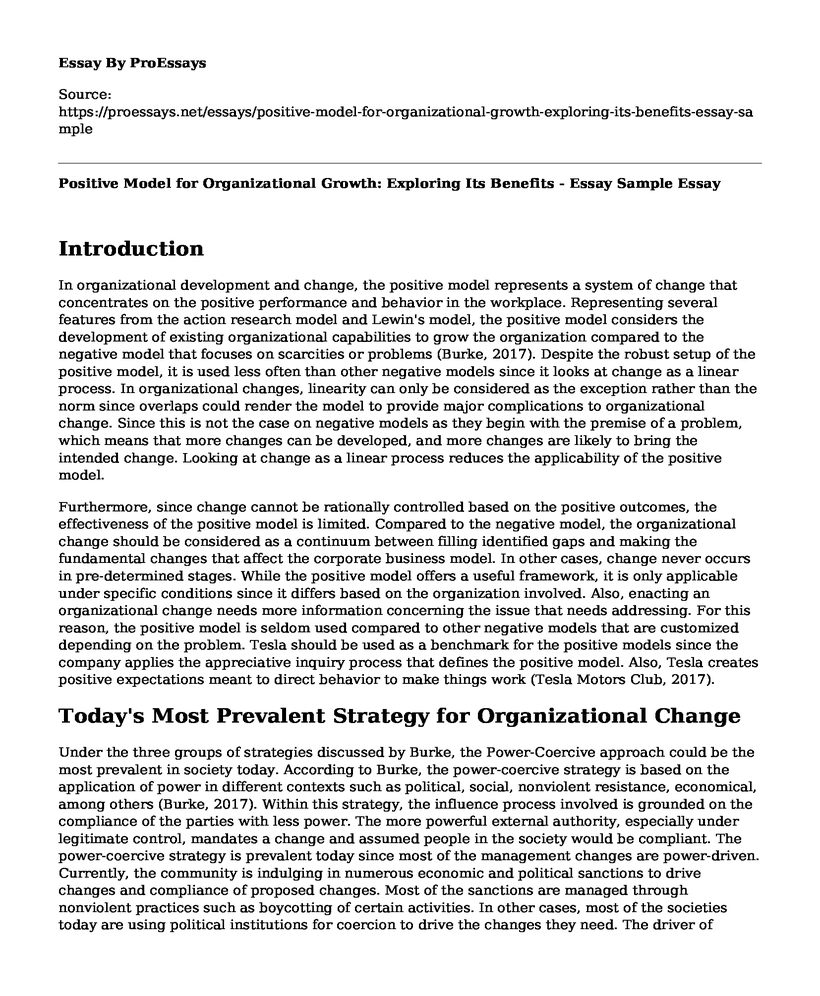Introduction
In organizational development and change, the positive model represents a system of change that concentrates on the positive performance and behavior in the workplace. Representing several features from the action research model and Lewin's model, the positive model considers the development of existing organizational capabilities to grow the organization compared to the negative model that focuses on scarcities or problems (Burke, 2017). Despite the robust setup of the positive model, it is used less often than other negative models since it looks at change as a linear process. In organizational changes, linearity can only be considered as the exception rather than the norm since overlaps could render the model to provide major complications to organizational change. Since this is not the case on negative models as they begin with the premise of a problem, which means that more changes can be developed, and more changes are likely to bring the intended change. Looking at change as a linear process reduces the applicability of the positive model.
Furthermore, since change cannot be rationally controlled based on the positive outcomes, the effectiveness of the positive model is limited. Compared to the negative model, the organizational change should be considered as a continuum between filling identified gaps and making the fundamental changes that affect the corporate business model. In other cases, change never occurs in pre-determined stages. While the positive model offers a useful framework, it is only applicable under specific conditions since it differs based on the organization involved. Also, enacting an organizational change needs more information concerning the issue that needs addressing. For this reason, the positive model is seldom used compared to other negative models that are customized depending on the problem. Tesla should be used as a benchmark for the positive models since the company applies the appreciative inquiry process that defines the positive model. Also, Tesla creates positive expectations meant to direct behavior to make things work (Tesla Motors Club, 2017).
Today's Most Prevalent Strategy for Organizational Change
Under the three groups of strategies discussed by Burke, the Power-Coercive approach could be the most prevalent in society today. According to Burke, the power-coercive strategy is based on the application of power in different contexts such as political, social, nonviolent resistance, economical, among others (Burke, 2017). Within this strategy, the influence process involved is grounded on the compliance of the parties with less power. The more powerful external authority, especially under legitimate control, mandates a change and assumed people in the society would be compliant. The power-coercive strategy is prevalent today since most of the management changes are power-driven. Currently, the community is indulging in numerous economic and political sanctions to drive changes and compliance of proposed changes. Most of the sanctions are managed through nonviolent practices such as boycotting of certain activities. In other cases, most of the societies today are using political institutions for coercion to drive the changes they need. The driver of change by decomposition and manipulation of power elites is another practice applied by societies today to push for transformative changes they require either short term or long term.
Force-Field Analysis
Kurt Lewin's force field analysis offers a framework for management to look at factors that influence social incidents. For instance, it shows and discusses forces either driving towards a goal or hindering the goal. In the case study of Franklyn Investments, a force-field analysis would be critical to develop a change plan and focus on the objective. In this case, the primary goal for Franklyn Investments is to guarantee benefits through employee retention and satisfaction.
References
Burke, W. W. (2017). Organization change: Theory and practice. Sage publications.
Tesla Motors Club. (2017). Optimistic Elon Musk's Moonshot Method - Tesla Motors Club. Tesla Motors Club. Retrieved from https://teslamotorsclub.com/blog/2017/11/28/optimistic-elon-musks-moonshot-method
Cite this page
Positive Model for Organizational Growth: Exploring Its Benefits - Essay Sample. (2023, Apr 05). Retrieved from https://proessays.net/essays/positive-model-for-organizational-growth-exploring-its-benefits-essay-sample
If you are the original author of this essay and no longer wish to have it published on the ProEssays website, please click below to request its removal:
- Factors Influencing the Choice of Products and Services Essay
- Technologies and Innovations in Supply Chain Management Paper Example
- Essay Sample on How Can HR Make A Strategic Contribution To This Organization?
- Essay Sample on DBQ on Ads and Campaigns
- Essay on SmartTech Consultants: 5-Year Strategic Plan for Up-Scaling & Quality Service
- Free Report Sample on Organizational Change: Strategies, Challenges for Effective Implementation
- Essay Example on Covid-19: Global Economic Impact & Government Measures







